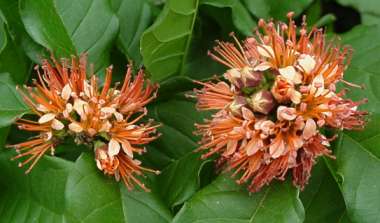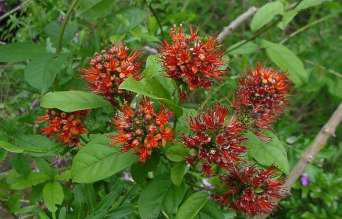Combretum bracteosum
Combretum bracteosum (Hochst.) Brandis
Family: Combretaceae
Common names: hiccough-nut, hiccup nut, hiccough creeper (Eng.); hikklimop (Afr.); uQotha (Xhosa)
SA Tree No: 532.2
Introduction
The Combretum bracteosum is unique amongst our bushwillows in that it does not have the characteristic, papery, four-winged fruit which is familiar to many people. The fruit, instead, is a hard, round nut. It also does have something to do with hiccups! Some say it causes them, others that it is a cure for hiccups. (It also may be harmful, so it is not something to be experimented with.)

Description
Description
The hiccup nut is a usually a shrub or small tree which scrambles into nearby vegetation. It grows up to between 2 and 4 m high, although if it has support from other trees it can reach up to 8 m. It spreads to between 4 and 5 m wide. Denzil Carr (1988) noted that the shrub is multistemmed, dense, and has unbranched stems which emerge from the top of the main crown. These have a sinuous appearance and when they touch another object which may offer support, they coil around it. Some of the stems are armed with curved spines. The leaves are simple and can be opposite, alternate or whorled, depending on where they are on the plant. The side veins of the leaves do not reach the margin (edge) of the leaf and loop into the side vein in front of it. The leaves are dark green in colour although very new leaves may have a purple tinge. Autumn colours are a reddish purple.

Flowering takes place in late spring (September, October) although it may flower later. The flowers are brilliant orange-red and clustered into infloresences. Flowering is profuse and creates a striking display. The fruit (± 20 mm across) appears between late summer and autumn (December to March) and is green, ripening to reddish brown; it is almost spherical and does not have wings, although it may be slightly 5-angled. It is a true nut in that it has a hard outer shell.
Distribution and habitat
Distribution description
Combretum bracteosum is found naturally along the coast in KwaZulu-Natal and the Eastern Cape. It grows in sand close to the sea, favouring dune forest and riverine forest (and their margins). Apparently it is very occasionally found somewhat inland from the sea, usually at low altitude and growing in sand. Its natural habitat is generally frost-free and with a reasonably high annual rainfall.
The family Combretaceae contains 20 genera around the world. Gardeners from warmer areas may know the exotic, sweetly scented Rangoon creeper, Quisqualis indica, which is also in this family. There are 250 species of Combretum worldwide in areas with warm climates, although not in Australia and the Pacific Islands. Approximately 30 of these occur in southern Africa.
Derivation of name and historical aspects
History
The name Combretum is derived from the word used by Pliny (a Roman writer on natural history dating from 23 to 79 AD) for a climbing plant; bracteosum refers to the bracts found at the base of the individual flower stalks. Meg Coates Palgrave (2002) writes that some botanists feel that this plant may in fact belong in another genus.
Ecology
Ecology
The hiccup nut is a host plant for the Striped Policeman butterfly, Coeliades forestan, which has a very strikingly marked caterpillar, yellowish white with dark brown to black stripes and an orange head. The adult is predominately brown and white with a striped abdomen.
Uses
Use
The roasted nuts are apparently eaten. There is confusion regarding its use medicinally - some references say that it is recorded as being used to cure hiccups, others that it causes them. Watt & Breyer-Brandwijk (1932), report that the plant does contain a toxic substance, saponin.
Growing Combretum bracteosum
Grow
The spectacular blaze of flowers make Combretum bracteosum a sought-after plant, especally in medium to large gardens (remember it can reach 5 m in diameter!). Although its natural habitat is in a warm climate, Denzil Carr writes that he grew the hiccup nut fairy successfully on the highveld but comments that it will need a good supply of water to really grow well. It apparently was not damaged by frost, although he does not say whether the plant was protected in any way. It may be wise to grow it in a protected position, perhaps against a west- or north-facing wall in frosty areas. For gardeners wishing to attract birds, this thick, tangled scrambling plant creates good nesting sites. Combretum bracteosum could be grown up a strongly constructed pergola, along a fence, or down a bank. To retain a shrub shape, prune off the long twining stems as they grow. It might prove helpful for gardeners battling against salt-laden winds, as it grows naturally close to the sea and enjoys sandy soil.
The hiccup nut may be grown from seed. The hard outer shells need to be cracked and the seeds removed. In general, Combretum seed needs to be fresh for successful germination. The seeds should then be soaked for 12 hours where they will absorb water, allowing germination to begin. You will see the seeds swell up. They can be grown lengthways on the seedling mix and covered lightly. Germination mostly takes place after 26 days, although some may start earlier. Seedlings can be transferred successfully to bags. In frosty areas allow the young plants to grow to a height of at least 0.5 m before planting out. Cuttings with a heel can also be used, as well as lifted rooted suckers from an established plant. Select well-drained areas for planting, as in its natural habitat it favours growing in sand. Add planty of good compost to the soil. Once planted out, flowering should occur in about three years.
References
- Arnold, T.H., Prentice, C.A., Hawker, L.C., Snyman, E.E.., Tomalin, M., Crouch, N.R. & Pottas-Bircher, C. 2002. Medicinal and magical plants of southern Africa: an annotated checklist. Strelitzia 13. National Botanical Institute, Pretoria.
- Carr, J.D. 1988. Combretaceae in southern Africa. The Tree Society of South Africa, Johannesburg.
- Coates Palgrave, M. 2002. Keith Coates Palgrave Trees of southern Africa, edn 3. Struik, Cape Town.
- Hanks, P. (ed.). 1979. Collins dictionary of the English language. Collins, London, Glasgow.
- Henning, G.A. & Henning, S.F. 1997. Living butterflies of southern Africa, vol. 1. Umdaus Press, Pretoria.
- Joffe, P. 2001. Creative gardening with indigenous plants: a South African guide. Briza Publications, Pretoria.
- Johnson, D. & Johnson, S. 1993. Gardening with indigenous trees and shrubs. Southern Books, Halfway House, Gauteng.
- Leistner, O.A. (ed.). 2000. Seed plants of southern Africa: families and genera. Strelitzia 10. National Botanical Institute, Pretoria.
- Manning, J. (Artists: Batten, A. & Bokelman, H.). 2001. Eastern Cape. South African Wild Flower Guide 11. The Botanical Society of South Africa, Cape Town.
- Pooley, E. 1993. The complete field guide to trees of Natal, Zululand and Transkei. Natal Flora Publications Trust, Durban.
- Smith, C.A. 1966. Common names of South African plants. Memoirs of the Botanical Survey of South Africa No. 35. Botanical Research Institute, Pretoria.
- Steyn, M. 1997. South African Combretum and Terminalia: identification guide. Published by author.
- Venter, F. & Venter, J-A. 1996. Making the most of indigenous trees. Briza Publications, Pretoria.
- Watt, J.M. & Breyer-Brandwijk, M.G. 1932. The medicinal and poisonous plants of southern Africa. Livingstone, Edinburgh.
Credits
Alice Aubrey
Walter Sisulu National Botanical Garden
June 2004
Plant Attributes:
Plant Type: Scrambler, Shrub, Tree
SA Distribution: Eastern Cape, KwaZulu-Natal
Soil type: Sandy
Flowering season: Spring
PH: Neutral
Flower colour: Red, Orange
Aspect: Full Sun
Gardening skill: Average
Special Features:
Horticultural zones









Rate this article
Article well written and informative
Rate this plant
Is this an interesting plant?
Login to add your Comment
Back to topNot registered yet? Click here to register.